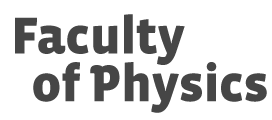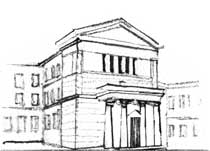The Trans-Carpathian Seminar on Geometry & Physics
(formerly Geometric Seminar)
2006/2007 | 2007/2008 | 2008/2009 | 2009/2010 | 2010/2011 | 2011/2012 | 2012/2013 | 2013/2014 | 2014/2015 | 2015/2016 | 2016/2017 | 2017/2018 | 2018/2019 | 2019/2020 | 2020/2021 | 2021/2022 | 2022/2023 | 2023/2024 | 2024/2025 | Seminar homepage
2013-06-05 (Wednesday)
Maria Sorokina (U. S. Petersburg)
Hamiltonian formalism on manifolds with singularities
The configuration spaces of many real mechanical systems appear to bemanifolds with singularity. A singularity often indicates that the geometryof motion may change at the point. In such cases we face the conceptualproblem describing mechanics even for ideal models: since the configurationspace is not a smooth manifold, thus, the fully developed machinery ofHamiltonian mechanics cannot be applied.I will present a way of conquering the aforementioned conceptual problem byconsidering a certain algebra instead of the configuration space.Configuration space is the real spectrum of the algebra. The structure ofthis algebra is completely determined by the geometry of the singularity.For a broad class of singularities the desired algebra can be describeddirectly since it is the pullback of two already known algebras which canbe easily described. Availability of the algebra enables to useDifferential operator theory.The elementary examples of mechanical systems to which this algorithm isapplicable, are flat linkages.In the frames of the presented approach a Poisson structure is built on amanifold with a one-dimensional singularity. The same result can beobtained for some other kinds of singularities.At the end of the talk I will present the specific results for the case ofa configuration space consisting of two curves on the plane having randomorder of contact.
2013-05-29 (Wednesday)
Paweł Urbański (KMMF)
Zasady zachowania bez symetrii
2013-05-22 (Wednesday)
Jose F. Carinena (U Zaragoza)
Recent results in the theory of Lie systems and its generalizations
A generalization of the concept of Lie systems (systems of first-order differential equations possessing a superposition rule) will be presented and the theory will be illustrated with several examples. Moreover, other recent results on applications in physics of Lie systems compatible with some geometric structures, as symplectic, presymplectic, or more generally Dirac structures, will also be discussed.
2013-05-15 (Wednesday)
Wojciech Domitrz (PW)
The Wigner caustic on shell and singularities of odd functions
2013-05-08 (Wednesday)
Mikołaj Rotkiewicz i Michał Jóźwikowski (IM PAN)
Variational calculus and higher Lie algebroids II
2013-04-24 (Wednesday)
Mikołaj Rotkiewicz i Michał Jóźwikowski (IM PAN)
Variational calculus and higher Lie algebroids
2013-04-17 (Wednesday)
Rafał Demkowicz-Dobrzański (IFT)
Metrologia kwantowa, czyli co?
Co geometria kanałów kwantowych może powiedzieć o interferometrach fal grawitacyjnych i zegarach atomowych.
2013-04-10 (Wednesday)
Piotr Sołtan (KMMF)
Algebry Hopfa
2013-03-27 (Wednesday)
Marek Kuś (CFT)
Lokalna równoważność stanów kwantowych
2013-03-20 (Wednesday)
Gabriel Pietrzkowski (IM PAN)
Rozwiązania explicite układu sterowania typu sl(2)
2013-03-13 (Wednesday)
Andrew James Bruce (IM PAN)
Odd Jacobi Manifolds and Jacobi algebroids
2013-03-06 (Wednesday)
Andrew James Bruce (IM PAN)
Odd Jacobi Manifolds and Jacobi algebroids
In this talk I will present some of the basic ideas of my approach to odd Jacobi manifolds and focus on applications in the theory of Jacobi algebroids and odd contact geometry. The talk will be based on "Odd Jacobi manifolds: general theory and applications to generalised Lie algebroids" Extracta Math. 27(1) (2012), 91-123.
2013-02-27 (Wednesday)
Michał Jóźwikowski (KMMF)
Teoria dżetów w/g Ehresmanna
2013-02-20 (Wednesday)
Mikołaj Rotkiewicz (IM PAN, IM UW)
Funktory Weila w supergeometrii
2013-01-23 (Wednesday)
Mikołaj Rotkiewicz (IM UW)
Funktory Weila w geometrii i supergeometrii
2013-01-16 (Wednesday)
Paweł Nurowski (CFT)
Local conformal invariants via Fefferman-Graham metrics
2013-01-09 (Wednesday)
Piotr Frąckiewicz (IM PAN)
Korelacje klasyczne, kwantowe i superkwantowe (cd)
2012-12-12 (Wednesday)
Piotr Frąckiewicz (IM PAN)
Korelacje klasyczne, kwantowe i superkwantowe
Podczas wykładu omówię różnice pomiędzy klasycznymi, kwantowymi isuperkwantowymi. W tym celu wykorzystam pojęcie nierówności Bella, wszczególności nierówność CHSH oraz problem opisany w pracy M. L. Almeida,J.-D. Bancal, N. Brunner, A. Acin, N. Gisin, S. Pironio: "Guess yourneighbour's input: a multipartite non-local game with no quantumadvantage" Phys. Rev. Lett. 104, 230404 (2010).
2012-11-28 (Wednesday)
Andriy Panasyuk (UWM)
O klasyfikacji par zgodnych nawiasów Liego, z których jeden jest półprosty
2012-11-21 (Wednesday)
Adam Bednorz (IFT)
Nieinwazyjny pomiar kwantowy
Standardowy, rzutowy pomiar kwantowy jest inwazyjny (ingeruje w układ)prowadzi do paradoksów:efektu Zenona i łamania nierówności Bella. Pomiar nieinwazyjny jestprzeciwieństwem rzutowego, unika powyższych paradoksów, ale prowadzi dozaskakujących nowych, np. łamania symetrii czasu.
2012-11-14 (Wednesday)
Elisa Guzman (U La Laguna)
Reduction for principal bundles and Tulczyjew's Triple
Some ideas about reduction for principal bundles arepresented. It is known that Classical Field theories of first order canbe formulated as Lagrangian submanifolds of premultisymplectic manifoldsthrough a particular Tulczyjew's Triple. In the case, the Classical Fieldtheories is a G-principal bundle a new triple and new Lagrangiansubmanifolds related with the previous ones are obtained to formulatedthe Euler-Poincare and the Hamilton-Poincare equations when theLagrangian and the Hamiltonian density are G-invariant.
2012-11-07 (Wednesday)
Andriy Panasyuk (UWM)
O klasyfikacji par zgodnych nawiasów Liego, z których jeden jest półprosty
2012-10-31 (Wednesday)
Michał Jóźwikowski (IM PAN)
Geometria wiązek dżetów (cd)
2012-10-24 (Wednesday)
Michał Jóźwikowski (IM PAN)
Geoetria wiązek dżetów
Podczas dwóch wykładów przedstawię wprowadzenie do przestrzeni dżetów. W szczególności omówię pojęcie dystrybucji Cartana i scharakteryzuje jej maksymalne całkowe podrozmaitości. Ten wynik posłuży do dowodu tw.Lie-Backlunda charakteryzującego wszystkie symetrie przestrzeni dżetów.Opowiem też o geometrycznym podejściu do cząstkowych równań różniczkowych io wiązkach nieskończonych dżetów i formalnej całkowalności.
2012-10-17 (Wednesday)
Paweł Nurowski (CFT)
Geometria toczących się powierzchni
2012-10-10 (Wednesday)
Michał Jóźwikowski (IM PAN)
Wiązki dżetów według Vinogradova (cd)
2012-10-03 (Wednesday)
Michał Jóźwikowski (IM PAN)







